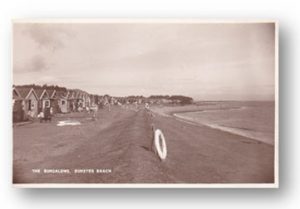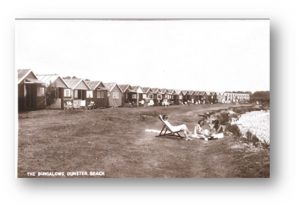A Brief History of Dunster Beach
1254 – Edward I granted The Hawn to Sir Reginald de Mohun of Dunster Castle. The Hawn, once a navigable channel through the sands and pebbles to Nap Lock ridge on Dunster beach is now landlocked. This freshwater lake was the old medieval port called Dunster Haven on the old course of the River Avill. The port had probably existed since the 12th century.
1279 – in the time of John de Mohun there is mention of the road which leads to the seaport of Dunster.
15th Century – Minehead developed as a port and gradually replaced Dunster. Not enough dues were paid to provide for the regular dredging of the channel to Dunster Haven which gradually silted up.
1565 – Dunster Haven was still available for small boats to land goods such as salt, wine, coal and wood.
1640s – Dunster Haven was still in use. There is a record of the Gift of Swansea paying 4 pence in keelage duty at Minehead on her way to Dunster during the Civil War.
17th Century – Dunster harbour had largely ceased to be used by the end of the century.
1920s – Dunster Beach began as a chalet site but with only one or two chalets.
1934 – a Miss Counsell visited the Castle office, chose a plot and built a chalet of Russian timber. Rent was £3 per annum including water and the use of a toilet block. The site had historically been used by travellers but was now closed to them.
1935 – Williton Rural District Council granted planning for nine chalets.

1945 – the Army left the site at the end of the war. The chalets were left in a disgraceful condition although this did not stop people trying to buy them cheaply on the morning after the Army left. Miss Counsell’s chalet had been used as a shoe repair shop and was “full of nails”. She complained to the CO and was given some compensation.
1945 – Mrs Hallett (Chalet 137) returned to the site to find to two Hurricane aircraft on the beach, they had landed by mistake on their way to Ireland.
1947 – Williton Rural District Council granted approval for further chalets.
1950 – Geoffrey Fownes Luttrell of Dunster Castle died and it was declared that lands enjoyed by his predecessors had been sold to the Eagle Star Insurance Company. This included Dunster Beach and the Hawn.
9th August 1955 – The Commissioners of Crown Lands granted a lease to Hutlands Ltd of the parcel of the land known as the Hawn. The Eagle Star Insurance Company offered the site for sale in 1956 but the Chalet Owners Association missed out to a higher rival bid.

1965 – The Chalet Owners Association managed to raise the funds (although a risky leap of faith involving bank loans, overdrafts and forming a co-operative) so when Dunster Beach came up for sale again the chalet owners purchased the site for £55,000. Beachlands (Dunster) Ltd became Dunster Beach Holidays …
Modern Day – Today Dunster Beach is a private site comprising of 230 chalets. They are all owned by families and individuals, many who have a long standing history with the beach as the chalets have been passed down from one generation to the next. The car park and main site are privately owned by Dunster Beach Holidays Ltd.
We continue to manage the site with care and attention to the conservation of the area. From 2017-2021 Dunster Beach Holidays has spent in excess of £100,000 on bolstering the sea defences, in order to preserve this wonderful piece of coastline.
If you would like to know more there is a History of Dunster Beach book which is available to buy from the kiosk.




